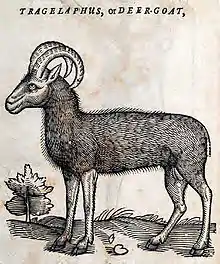Hircocervus
The hircocervus (Latin: hircus, "billy goat" + cervus, "stag") or tragelaph (Greek: τράγος, romanized: tragos, "billy goat" + έλαφος, elaphos, "stag"), also known as a goat-stag, was a legendary creature imagined to be half-goat, half-stag.

Origins
In Plato's Republic, Socrates speaks of his own image-making as similar to that of painters who paint goat-stags, combining the features of different things together (488a).[1]
In his work De Interpretatione,[2] Aristotle utilized the idea of a fabulous goat-stag to express the philosophical concept of something that is describable even though it does not really exist.[3] He returns to this in the Posterior Analytics[4] to argue that, though the word is definable, there can be no definition of the species as it has no members. He also uses the tragelaphos together with the Sphinx in the Physics[5] to illustrate the point that a non-existent creature has no spatial location.
On the other hand, Diodorus Siculus[6] treats the tragelaphos as an existing animal, and there are references in Greek literature to other hybrid creatures such as the hippelaphos (horse-stag).
The word hircocervus first appears in the English language in a medieval manuscript dating from 1398 (now at the Bodleian Library).[3]
In culture
Rabbinic literature refers to an animal called a koy which is halfway between domesticated and wild species of quadruped, and debates how far it is subject to the laws governing each category.[7] Scholars are divided on whether the rabbis believed the koy to be a real creature[8] or an imaginary example used for a hypothetical discussion.[9]
Martin Luther uses the term "Goat-stag" (tragelaphus in his Latin) in his Theses Against the Antinomians (1540, Sixth Set) to describe "a law that does not condemn". Luther is stating that one can imagine a law from God that only instructs or teaches without threatening and condemning human sin. However, Luther claims that such a law, often sought by theologians throughout Christian history, does not actually exist.[10]
The Trusty Servant, depicted in a painting at Winchester College, was described as a Hircocervus by Arthur Cleveland Coxe,[11] though this is not strictly accurate as the Trusty Servant contains no part of a goat but rather parts of a man, a hog and a donkey.
Umberto Eco refers to a hircocervus in his novel The Island of the Day Before,[3] as does Italo Calvino in Invisible Cities.[12]
Italian Marxist philosopher Antonio Gramsci uses the term hircocervus to describe parliamentary political alliances between socialist parties and parties sympathetic to the state and capitalism. The dual party of socialists and capitalists "thus becomes a hircocervus, a historical monster devoid of will or particular aims, concerned only with its possession of the state." [13]
References
- Plato Republic. 488a.
- Ch. 1, 16a16.
- Quinion, Michael (2009). "Hircocervus". World Wide Words. Retrieved February 8, 2009.
- Book 2 ch. 7 92a 7.
- Book 4 ch. 1 208a 30.
- Bibliotheca Historica p. 322.
- Mishnah Bikkurim 2.8-11.
- Shaye J. D. Cohen, “Sabbath Law and Mishnah Shabbat in Origen De Principiis”, Jewish Studies Quarterly Vol. 17, No. 2, Special Issue: Jews in Ottoman Lands II (2010), pp. 160-189.
- Judith Romney Wegner “Tragelaphos Revisited: the Anomaly of Woman in the Mishnah” Judaism 37.2 160-172.
- Luther, Martin. Weimar Ausgabe. 39I:358.26-27; Luther, Martin. Solus Decalogus Est Aeternus: Martin Luther's Complete Antinomian Theses and Disputations. Ed. and trans. Holger Sonntag. Latin and English ed. (Minneapolis: Lutheran Press, 2008): 375.
- Arthur Cleveland Coxe, Impressions of England. (1874) (Google Books)
- Calvino, Italo. Invisible Cities. 1997, Vintage: London. Pp. 144
- Gramsci, Antonio (2000). "Class Intransigence and Italian History". In Forgacs, David (ed.). The Gramsci Reader: Selected Writings, 1916-1935 (PDF). New York: New York University Press. p. 43. ISBN 9780814727010. Retrieved 13 December 2018.